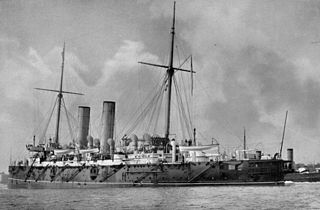
HMS Gibraltar, was an Edgar-class cruiser launched in 1892 for service in the Royal Navy. She was built and engineered by Messrs Napier of Glasgow. Of 7,700 loaded displacement, she was coal-fired with four double-ended cylindrical boilers driving two shafts. She could make 20 knots (37 km/h) with forced draught and 18 knots (33 km/h) with natural draught. She was a very good sea boat and an exceptional steamer.
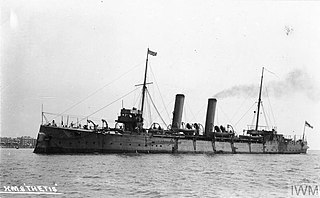
HMS Thetis was an Apollo-class 2nd class protected cruiser of the Royal Navy, launched on 13 December 1890. Her first significant mission was service in the Bering Sea Patrol with American warships in a combined effort to suppress poaching in the Bering Sea.

HMS Hawke, launched in 1891, was the seventh British warship to be named Hawke. She was an Edgar-class protected cruiser.

HMS Edgar was a first class cruiser of the Royal Navy, and lead ship of the Edgar class. She was built at Devonport and launched on 24 November 1890. She served on the China Station, and in the First World War in the Gallipoli Campaign, along with her sisters Endymion, Grafton and Theseus.

HMS Grafton was a first class cruiser of the Edgar class, launched in 1892. She served in colonial service and in the First World War. Grafton survived the war and was broken up in the 1920s.
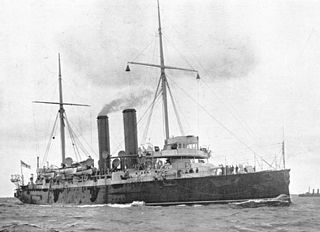
HMS St George was a first class cruiser of the Edgar class. She was launched on 23 June 1892.
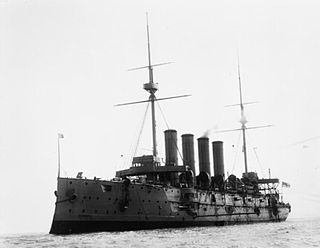
HMS Diadem was the lead ship of the Diadem-class of protected cruiser in the Royal Navy.

HMS Andromeda was one of eight Diadem-class protected cruisers built for the Royal Navy in the 1890s. Upon completion in 1899, the ship was assigned to the Mediterranean Fleet where she helped to escort a royal yacht during its cruise through the Mediterranean Sea. After a refit, she was assigned to the China Station in 1904 and returned home three years later to be reduced to reserve. Andromeda was converted into a training ship in 1913 and remained in that role under various names until 1956. That year she was sold for scrap and broken up in Belgium, the last Pembroke-built ship still afloat.

HMS Ariadne was a Diadem-class protected cruiser of the Royal Navy, which was launched in 1898, In March 1913, she was converted to a stokers' training ship and in 1917 was converted to a minelayer and assigned to the Nore Command. She was torpedoed and sunk off Beachy Head by the German submarine UC-65 on 26 July 1917.

HMS Europa was a ship of the Diadem-class protected cruisers in the Royal Navy. She was built by J&G Thompson of Clydebank and launched on 20 March 1897.
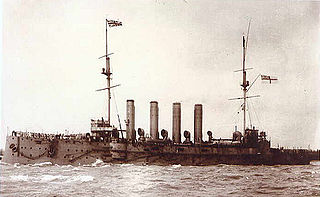
HMS Spartiate was a ship of the Diadem-class protected cruisers in the Royal Navy. She was built at Pembroke Dock and launched on 27 October 1898. She was a stokers' training ship in 1914 and was renamed Fisgard in June 1915. She survived the First World War and was sold in July 1932. She returned to Pembroke to be broken up.

HMS Blake, named in honour of Admiral Robert Blake, was the lead ship of her class of protected cruiser that served in the Royal Navy from 1889 to 1922.

HMS Flora was an Astraea-class cruiser of the Royal Navy launched on 21 November 1893. She was constructed under the Naval Defence Act 1889 along with several other Astraea-class cruisers. Flora was decommissioned in 1922.

HMS Astraea was an Astraea-class second class cruiser of the Royal Navy. She was built towards the end of the nineteenth century, and survived to serve in the First World War.

The sixth HMS Harrier was a Dryad-class torpedo gunboat. She was launched at Devonport Dockyard on 20 February 1894, and saw service in the Mediterranean and in fishery protection. She served as a minesweeper during World War I and was sold for commercial use in 1920.

HMS Diana was an Eclipse-class protected cruiser built for the Royal Navy in the mid-1890s.

HMS Latona was an Apollo-class protected cruiser of the Royal Navy which served from 1890 to 1920.
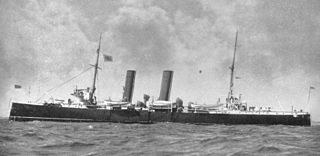
HMS Melampus was an Apollo-class protected cruiser of the Royal Navy which served from 1890 to 1910.
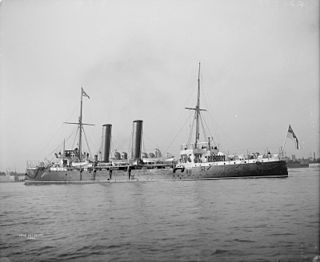
HMS Intrepid was an Apollo-class protected cruiser of the Royal Navy built on the River Clyde and launched in 1891. She was subsequently converted as a minelayer and sunk as a blockship during the Zeebrugge Raid on 23 April 1918.

HMS Naiad was an Apollo-class protected cruiser of the Royal Navy which served from 1892 to 1919.




















